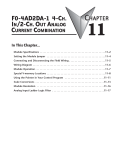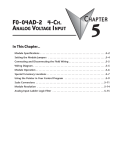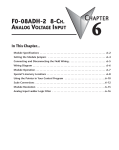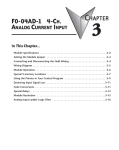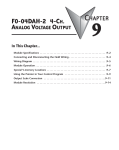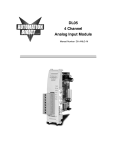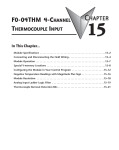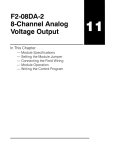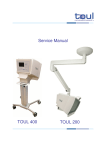Download Chapter 12 - AutomationDirect
Transcript
F0-2AD2DA-2 2-CH. IN/2-CH. OUT ANALOG VOLTAGE COMBINATION CHAPTER 12 In This Chapter... Module Specifications . . . . . . . . . . . . . . . . . . . . . . . . . . . . . . . . . . . . . . . . . . . . . . .12–2 Setting the Module Jumpers . . . . . . . . . . . . . . . . . . . . . . . . . . . . . . . . . . . . . . . . .12–4 Connecting and Disconnecting the Field Wiring . . . . . . . . . . . . . . . . . . . . . . . . . .12–5 Wiring Diagram . . . . . . . . . . . . . . . . . . . . . . . . . . . . . . . . . . . . . . . . . . . . . . . . . . . .12–5 Module Operation . . . . . . . . . . . . . . . . . . . . . . . . . . . . . . . . . . . . . . . . . . . . . . . . . .12–6 Special V-memory Locations . . . . . . . . . . . . . . . . . . . . . . . . . . . . . . . . . . . . . . . . . .12–7 Using the Pointer in Your Control Program . . . . . . . . . . . . . . . . . . . . . . . . . . . .12–10 Scale Conversions . . . . . . . . . . . . . . . . . . . . . . . . . . . . . . . . . . . . . . . . . . . . . . . . .12–12 Module Resolution . . . . . . . . . . . . . . . . . . . . . . . . . . . . . . . . . . . . . . . . . . . . . . . .12–15 Analog Input Ladder Logic Filter . . . . . . . . . . . . . . . . . . . . . . . . . . . . . . . . . . . . .12–16 Chapter 12: F0-2AD2DA-2 2-Ch. In/2-Ch. Out Analog Voltage Combination 1 2 3 4 5 6 7 8 9 10 11 12 13 14 A B C D Module Specifications 12–2 The F0-2AD2DA-2 Analog Combination module offers the following features: The analog input and output channels are updated in one scan. • The module has a removable terminal block which makes it possible to remove the module without disconnecting the field wiring. • Analog inputs can be used as process variables for the four (4) PID loops in the DL05 and the eight (8) PID loops in the DL06 CPUs. • On-board active analog filtering and RISC-like microcontroller provide digital signal processing to maintain precise analog measurements in noisy environments. NOTE: The DL05 CPU’s analog feature for this module requires DirectSOFT32 Version 3.0c (or later) and firmware version 3.30 (or later). The DL06 requires DirectSOFT32 version V4.0, build 16 (or later) and firmware version 1.00 (or later). See our website for more information: www.automationdirect.com. DL05/06 Option Modules User Manual; 7th Ed. Rev. A, 08/11 Chapter 12: F0-2AD2DA-2 2-Ch. In/2-Ch. Out Analog Voltage Combination The following tables provide the specifications for the F0–2AD2DA–2 Analog Voltage Combination Module. Review these specifications to make sure the module meets your application requirements. Input Specifications Number of Channels Input Range Resolution Step Response Crosstalk Active Low-pass Filtering Input Impedance Absolute Maximum Ratings Linearity Error (End to End) Input Stability Gain Error Offset Error Maximum Inaccuracy Accuracy vs. Temperature 2, single ended (one common) 0 to 5 VDC or 0 to 10 VDC (jumper selectable) 12 bit (1 in 4096) 10.0 mS to 95% of full step change 1/2 count maximum (-80db)* -3 dB at 300Hz (-12 dB per octave) Greater than 20K⏲ ± 15V ±2 counts (0.025% of full scale) maximum* ± 1 count * ± 6 counts * ± 2 counts * 0.3% @ 25°C (77°F) 0.6% 0 to 60°C (32 to 140°F) ±100 ppm/°C typical Output Specifications Number of Channels 2, single ended (one common) Output Range 0 to 5 VDC or 0 to 10 VDC (jumper selectable) Resolution 12 bit (1 in 4096) Conversion Settling Time 50µS for full scale change Crosstalk 1/2 count maximum (-80db) * Peak Output Voltage ± 15 VDC (power supply limited) Offset Error 0.1% of range Gain Error 0.4% of range Linearity Error (end to end) ±1 count (0.075% of full scale) maximum* Output Stability ± 2 counts* 2K⏲ minimum Load Impedance Load Capacitance 0.01 µF maximum Accuracy vs. Temperature ±50 ppm/°C typical * One count in the specification table is equal to one least significant bit of the analog data value (1 in 4096). DL05/06 Option Modules User Manual; 7th Ed. Rev. A, 08/11 1 2 3 4 5 6 7 8 9 10 11 12 13 14 A B C D 12–3 Chapter 12: F0-2AD2DA-2 2-Ch. In/2-Ch. Out Analog Voltage Combination General Specifications 2 input channels per scan 2 output channels per scan 12 binary data bits 0 to 60° C (32 to 140° F) -20 to 70° C (-4 to 158° F) 5 to 95% (non-condensing) No corrosive gases permitted MIL STD 810C 514.2 MIL STD 810C 516.2 NEMA ICS3-304 50 mA @ 5 VDC (supplied by base) 30 mA, 24 VDC ±10% Phoenix Mecano, Inc. Part No. AK1550/8-3.5 - green 28 - 16 AWG 0.4 Nm DN-SS1 (recommended) 1 2 3 4 5 6 7 the Module Jumpers 8 SettingThe position of the J2 jumpers determines the input and output signal levels. You can choose between 0–5 VDC or 0–10 VDC. The module ships with the jumpers connecting the pins. In 9 this position, the input and output signal level is 0–5 VDC. To select 0–10 VDC signals, use the jumper setting chart located on the module. One or more channels can be selected for 0–10 VDC input and output signal level by removing the jumper from the connecting pins of the 10 appropriate channel. This will allow you to have one channel selected for a 0–5 VDC signal and another channel selected for a 0–10 VDC signal. 11 12 13 14 A B WARNING: Before removing the analog module or the terminal block on the face of the module, disconnect power to the PLC and all field devices. Failure to disconnect power can result in damage to the PLC and/or field devices. C D PLC Update Rate 16-bit Data Word Operating Temperature Storage Temperature Relative Humidity Environmental Air Vibration Shock Noise Immunity Power Budget Requirement External Power Supply Connector Connector Wire Size Connector Screw Torque Connector Screwdriver Size J2, jumpers shown below, are configured as, CH1 INPUT and CH2 OUTPUT both set for 10V. CH2 INPUT and CH1 OUTPUT both set for 5V. J2 (JUMPERS) F0–2AD2DA–2 C20 OUT CH1 CH2 CH1 12–4 CH2 Refer to jumper setting chart. ON=5V INPUT DL05/06 Option Modules User Manual; 7th Ed. Rev. A, 08/11 Chapter 12: F0-2AD2DA-2 2-Ch. In/2-Ch. Out Analog Voltage Combination Connecting and Disconnecting the Field Wiring Wiring Guidelines Your company may have guidelines for wiring and cable installation. If so, you should check those before you begin the installation. Here are some general things to consider: • Use the shortest wiring route whenever possible. • Use shielded wiring and ground the shield at the transmitter source. Do not ground the shield at both the module and the source. • Do not run the signal wiring next to large motors, high current switches, or transformers. This may cause noise problems. • Route the wiring through an approved cable housing to minimize the risk of accidental damage. Check local and national codes to choose the correct method for your application. The F0–2AD2DA–2 will require an external power supply with a rating of 18.0–26.4VDC at 30 mA. To remove the terminal block, disconnect power to the PLC and the field devices. Pull the terminal block firmly until the connector separates from the module. You can remove the analog module from the PLC by folding out the retaining tabs at the top and bottom of the module. As the retaining tabs pivot upward and outward, the module’s connector is lifted out of the PLC socket. Once the connector is free, you can lift the module out of its slot. Wiring Diagram Use the following diagram to connect the field wiring. If necessary, the F0–2AD2DA–2 terminal block can be removed to make removal of the module possible without disturbing field wiring. Typical User Wiring Transmitter Power Supply + – Internal Module Wiring See NOTE 1 – CH1 4–wire Voltage Transmitter CH2 2–wire Voltage Transmitter + – 1 + IN 2 – 0V Analog Switch + 1 OUT 2 CH 1 load 2k ohms minimum Resistance Ch 1 Voltage Source Ch 2 A to D Converter 1 IN 2 D to A Converter 0V D to A Converter 0V 1 OUT 2 V+ 24V 0V V+ 24V 0V Voltage Source CH 2 load 2k ohms minimum Resistance A n a l o g In/Out 2–In/2–Out 0–5V 0–10V 0V F0–2AD2DA–2 NOTE 1: Shields should be grounded at the signal source. NOTE 2: Connect all external power supply commons. – + 18.0–26.4VDC Power Supply OV 1 2 3 4 5 6 7 8 9 10 11 12 13 14 A B C D Module Supply DL05/06 Option Modules User Manual; 7th Ed. Rev. A, 08/11 12–5 Chapter 12: F0-2AD2DA-2 2-Ch. In/2-Ch. Out Analog Voltage Combination 1 2 3 4 5 6 7 8 9 10 11 12 13 14 A B C D Module Operation 12–6 Input/Output Channel Scanning Sequence The DL05 and DL06 read two channels of input and two channels of output data during each scan. The CPU supports special V-memory locations that are used to manage the data transfer. This is discussed in more detail on the following page, “Special V–memory Locations”. Scan DL05/DL06 PLC Read Inputs Execute Application Program Read the data Store data Scan N Ch 1, 2 IN; Ch 1,2 OUT Scan N+1 Ch 1, 2 IN; Ch 1,2 OUT Scan N+2 Ch 1, 2 IN; Ch 1,2 OUT Scan N+3 Ch 1, 2 IN; Ch 1,2 OUT Scan N+4 Ch 1, 2 IN; Ch 1,2 OUT Write to Outputs Analog Module Updates Even though the channel updates to the CPU are synchronous with the CPU scan, the module asynchronously monitors the analog transmitter signals and converts each signal into a 12-bit binary representation. This enables the module to continuously provide accurate measurements without slowing down the discrete control logic in the RLL program. The module takes approximately 10 milliseconds to sense 95% of the change in the analog signal. For the vast majority of applications, the process changes are much slower than these updates. NOTE: If you are comparing other manufacturers’ update times (step responses) with ours, please be aware that some manufacturers refer to the time it takes to convert the analog signal to a digital value. Our analog to digital conversion takes only a few microseconds. It is the settling time of the filter that is critical in determining the full update time. Our update time specification includes the filter settling time. DL05/06 Option Modules User Manual; 7th Ed. Rev. A, 08/11 Chapter 12: F0-2AD2DA-2 2-Ch. In/2-Ch. Out Analog Voltage Combination Special V-memory Locations Formatting the Module Data The DL05 and DL06 PLCs have three special V-memory locations assigned to their respective option slots These V-memory locations allow you to: • specify the data format (binary or BCD) • specify the number of I/O channels to scan (2 input and 2 output channels for the F0–2AD2DA–2) • specify the V-memory locations to store the input data • specify the V-memory locations to store the output data DL05 Data Formatting The table below shows the special V-memory locations used by the DL05 PLC for the analog combination modules. Analog Combination Module DL05 Special V-memory Locations Data Type and Number of I/O Channels Input Storage Pointer Output Storage Pointer V7700 V7701 V7702 Structure of V7700 V–memory location 7700 is used for identifying the number of output channels, the number of input channels and the data type (binary or BCD). The low byte equals the number of output channels and the high byte equals the number of input channels. Either a 1 or a 2 will be entered to select the number of input and output channels to be used. A zero (0) entered for channel selection will cause the channel, either input or output, to be inoperative. Loading a constant of 202 into V7700 identifies MSB LSB two input and two output analog channels, and LOW BYTE sets the I/O data type to BCD. Loading a constant of 8282 into V7700 MSB LSB identifies two input and two output analog channels, and sets the I/O data type to binary. HIGH BYTE Structure of V7701 V7701 is a system parameter that points to a V-memory location used for storing analog input data. The V–memory location loaded in V7701 is an octal number identifying the first Vmemory location for the analog input data. This V–memory location is user selectable. For example, loading O2000, using the LDA instruction,causes the pointer to write Ch 1’s data value to V2000 and Ch 2’s data value to V2001. DL05/06 Option Modules User Manual; 7th Ed. Rev. A, 08/11 1 2 3 4 5 6 7 8 9 10 11 12 13 14 A B C D 12–7 Chapter 12: F0-2AD2DA-2 2-Ch. In/2-Ch. Out Analog Voltage Combination Structure of V7702 1 2 3 4 5 6 7 8 9 10 11 12 13 14 A B C D 12–8 V7702 is a system parameter that points to a V-memory location used for storing analog output data. The V–memory location loaded in V7702 is an octal number identifying the first Vmemory location for the analog output data. This V–memory location is user selectable. For example, loading O2010, using the LDA instruction, causes the pointer to write Ch 1’s datavalue from V2010 and Ch 2’s data value from V2011. You will find an example program that loads appropriate values to V7700, V7701 and V7702 on page 12–10. DL05/06 Option Modules User Manual; 7th Ed. Rev. A, 08/11 Chapter 12: F0-2AD2DA-2 2-Ch. In/2-Ch. Out Analog Voltage Combination DL06 Data Formatting Special V–memory locations are assigned to the four option module slots of the DL06 PLC. The table below shows these V–memory locations which can be used by the F0–2AD2DA–2. Analog Combination Module DL06 Special V-memory Locations Slot No. Number of Channels Input Pointer Output Pointer 1 V700 V701 V702 2 V710 V711 V712 3 V720 V721 V722 4 V730 V731 V732 Setup Data Type and Number of Channels V–memory locations 700, 710, 720 and 730 are used for identifying the number of output channels, the number of input channels and the data type (binary or BCD). The low byte equals the number of output channels and the high byte equals the number of input channels. Enter a 1 or 2 to select the number of input and output channels to be used. A zero (0) entered for channel selection will cause the channel, either input or output, to be inoperative. For example, with a module installed in slot 1 by MSB LSB loading a constant of 202 into V700 identifies two LOW BYTE input and two output analog channels, and sets the I/O data type to BCD. MSB LSB And, loading a constant of 8282 into V700 identifies two input and two output analog HIGH BYTE channels, and sets the I/O data type to binary. Input Storage Pointer V–memory locations 701, 711, 721 and 731 are special locations used as a storage pointers for the analog input data. With the analog module installed in slot 1, the V–memory location loaded in V701 is an octal number identifying the first user V-memory location to read the analog input data. This V–memory location is user selectable. For example, loading O2000, using the LDA instruction, causes the pointer to write Ch 1’s data value to V2000 and Ch 2’s data value to V2001. Output Storage Pointer V–memory locations 702, 712, 722 and 732 are special locations used as storage pointer for the analog output data. With the analog module installed in slot 1, the V–memory location loaded in V702 is an octal number identifying the first user V-memory location to write the analog output data to. This V–memory location is user selectable. For example, loading O2010, using the LDA instruction, causes the pointer to write Ch 1’s data value from V2010 and Ch 2’s data value from V2011. You will find an example program that loads appropriate values to V700, V701 and V702 on page 12–11. DL05/06 Option Modules User Manual; 7th Ed. Rev. A, 08/11 1 2 3 4 5 6 7 8 9 10 11 12 13 14 A B C D 12–9 Chapter 12: F0-2AD2DA-2 2-Ch. In/2-Ch. Out Analog Voltage Combination 1 2 3 4 5 6 7 8 9 10 11 12 13 14 A B C D Using the Pointer in Your Control Program DL05 Pointer Method 12–10 The DL05 CPU examines the pointer values (the memory locations identified in V7700, V7701 and V7702) on the first scan only. The example program below shows how to setup these locations for 2 input channels and 2 output channels. This rung can be placed anywhere in the ladder program or in the initial stage if you are using stage programming instructions. This is all that is required to read the analog input data into V-memory locations. Once the data is in V-memory you can perform mathematical calculations with the data, compare the data against preset values, and so forth. V2000 and V2010 is used in the example but you can use any user V-memory location. SP0 LD K202 - or LD K8282 Load a constant that specifies the number of channels to scan and the data format. The upper byte selects the input data format (i.e. 0=BCD, 8=Binary) and the number of input channels (set to either 1 or 2 for the F0–2AD2DA–2). The lower byte selects the output data format (i.e. 0=BCD, 8=Binary) and the number of output channels (set to either 1 or 2). The binary format is used for displaying data on some operator interface units. The DL05 PLCs support binary math functions. OUT V7700 Special V-memory location assigned to the option slot contains the data format and the number of channels to scan. LDA O2000 This loads an octal value for the first V-memory location that will be used to store the incoming data. For example, the O2000 entered here using the LDA instruction would designate the following addresses: Ch1 – V2000, Ch2 – V2001 OUT V7701 LDA O2010 OUT V7702 The octal address (O2000) is stored here. V7701 is assigned to the option slot and acts as a pointer, which means the CPU will use the octal value in this location to determine exactly where to store the incoming data. This loads an octal value for the first V-memory location that will be used to store the output data. For example, the O2010 entered here using the LDA instruction would designate the following addresses: Ch1 – V2010, Ch2 – V2011 The octal address (O2010) is stored here. V7702 is assigned to the option slot and acts as a pointer , which means the CPU will use the octal value in this location to determine exactly where to store the output data. DL05/06 Option Modules User Manual; 7th Ed. Rev. A, 08/11 Chapter 12: F0-2AD2DA-2 2-Ch. In/2-Ch. Out Analog Voltage Combination DL06 Pointer Method Use the special V–memory table as a guide to setup the pointer values in the following example for the DL06. Slot 1 is the left most option slot. The CPU will examine the pointer values at these locations only after a mode transition, first scan only. Analog Combination Module DL06 Special V-memory Locations Slot No. Number of Channels Input Pointer Output Pointer 1 V700 V701 V702 2 V710 V711 V712 3 V720 V721 V722 4 V730 V731 V732 The F0–2AD2DA–2 can be installed in any available DL06 option slot. Using the example program from the previous page, but changing the V–memory addresses, the ladder diagram below shows how to setup these locations for 2 input channels and 2 output channels with the module installed in slot1 of the DL06. Use the above table to determine the pointer values if locating the module in any of the other slot locations. Place this rung anywhere in the ladder program or in the initial stage if you are using stage programming instructions. Like the DL05 example, this logic is all that is required to read the analog input data into Vmemory locations. Once the data is in V-memory you can perform mathmatical calculations with the data, compare the data against preset values, and so forth. V2000 and V2010 is used in the example but you can use any user V-memory location. SP0 LD K202 - or LD K8282 Loads a constant that specifies the number of channels to scan and the data format. The upper byte selects the input data format (i.e. 0=BCD, 8=Binary) and the number of input channels (set to either 1 or 2 for the F0–2AD2DA–2). The lower byte selects the output data format (i.e. 0=BCD, 8=Binary) and the number of output channels (set to either 1 or 2). The binary format can be used for displaying data on some operator interface units and on the DL06 LCD display. The DL06 PLCs support binary math functions. OUT V700 Special V-memory location assigned to the first option slot contains the data format and the number of channels to scan. LDA O2000 This loads an octal value for the first V-memory location that will be used to store the incoming data. For example, O2000 entered here using the LDA instruction would designate the following addresses: Ch1 – V2000, Ch2 – V2001 OUT V701 LDA O2010 OUT V702 The octal address (O2000) is stored here. V701 is assigned to the first option slot and acts as a pointer, which means the CPU will use the octal value in this location to determine exactly where to store the incoming data. This loads an octal value for the first V-memory location that will be used to store the output data. For example, O2010 entered here using the LDA instruction would designate the following addresses: Ch1 – V2010, Ch2 – V2011 The octal address (O2010) is stored here. V702 is assigned to the first first slot and acts as a pointer , which means the CPU will use the octal value in this location to determine exactly where to store the output data. DL05/06 Option Modules User Manual; 7th Ed. Rev. A, 08/11 1 2 3 4 5 6 7 8 9 10 11 12 13 14 A B C D 12–11 Chapter 12: F0-2AD2DA-2 2-Ch. In/2-Ch. Out Analog Voltage Combination 1 2 3 4 5 6 7 8 9 10 11 12 13 14 A B C D Scale Conversions Scaling the Input Data 12–12 Many applications call for measurements in engineering units, which can be more meaningful than raw data. Convert to engineering units using the formula shown to the right. You may have to make adjustments to the formula depending on the scale you choose for the engineering units. Units = A H – L + L 4095 H = High limit of the engineering unit range L = Low limit of the engineering unit range For example, if you wanted to measure pressure (PSI) from 0.0 to 100.0 then you would have to multiply the analog value by 10 in order to imply a decimal place when you view the value with the programming software or a handheld programmer. Notice how the calculations differ when you use the multiplier. Analog Value of 2024, slightly less than half scale, should yield 49.4 PSI. Example without multiplier Example with multiplier Units = A H – L + L 4095 Units = 10 A H – L + L 4095 Units = 2024 100 – 0 + 0 4095 Units = 20240 100 – 0 + 0 4095 Units = 49 Units = 494 DL05/06 Option Modules User Manual; 7th Ed. Rev. A, 08/11 Chapter 12: F0-2AD2DA-2 2-Ch. In/2-Ch. Out Analog Voltage Combination The Conversion Program The following example shows how you would write the program to perform the engineering unit conversion from the input data format 0–4095. This example assumes the raw input data read at V2000 is in BCD format. Note: this example uses SP1, which is always on. You could also use an X, C, etc. permissive contact. SP1 LD V2000 When SP1 is on, load Ch 1 data to the accumulator. MUL K1000 Multiply the accumulator by 1000 (for the range of 0–1000). DIV K4095 Divide the accumulator by 4095(the module resolution). OUT V2100 Store the result in V2100. Output Conversion Program The following example program shows how you would write the program to convert the engineering unit to the output data format 0–4095. This example assumes you have calculated or loaded the engineering unit values between 0–1000 in BCD format and stored them in V2300 and V2301 for channels 1 and 2 respectively. Both the DL05 and DL06 offer instructions that allow you to perform math operations using BCD format. It is usually easier to perform any math calculations in BCD and then convert the value to binary before you send the data to the module. SP1 LD V2300 The LD instruction loads the engineering units used with channel 1 into the accumulator. This example assumes the numbers are BCD. Since SP1 is used, this rung automatically executes on every scan. You could also use an X, C, etc. permissive contact. MUL K4095 Multiply the accumulator by 4095. DIV K1000 Divide the accumulator by 1000 (this is the maximum value of V2300). OUT V2010 Store the BCD result in V2010; the V–memory location set up to send the data to Ch 1 output. SP1 LD V2301 MUL K4095 DIV K1000 OUT V2011 The LD instruction loads the engineering units used with Ch 2 into the accumulator. This example assumes the numbers are BCD. Since SP1 is used, this rung automatically executes on every scan. You could also use an X, C, etc. permissive contact. Multiply the accumulator by 4095. Divide the accumulator by 1000 (this is the maximum value of V2301). Store the BCD result in V2011; the V–memory location set up to send the data to Ch 2 output. DL05/06 Option Modules User Manual; 7th Ed. Rev. A, 08/11 1 2 3 4 5 6 7 8 9 10 11 12 13 14 A B C D 12–13 Chapter 12: F0-2AD2DA-2 2-Ch. In/2-Ch. Out Analog Voltage Combination Analog and Digital Value Conversions 1 2 3 4 5 6 7 8 9 10 11 12 13 14 A B C D 12–14 Sometimes it is useful to convert between the signal levels and the digital values. This is especially helpful during machine startup or troubleshooting. The following table provides formulas to make this conversion easier. Range If you know the digital value If you know the analog signal level 0 to 5V A = 5D 4095 D = 4095 (A) 5 0 to 10V A = 10D 4095 D = 4095 (A) 10 For example, if you are using the 0–10V range and you need a 6V signal level, use this formula to determine the digital value (D) that will be stored in the V-memory location that contains the data. D = 4095 (A) 10 4095 (6V) D= 10 D = (409.5) (6) DL05/06 Option Modules User Manual; 7th Ed. Rev. A, 08/11 D = 2457 Chapter 12: F0-2AD2DA-2 2-Ch. In/2-Ch. Out Analog Voltage Combination Module Resolution Analog Data Bits The first twelve bits represent the analog data for both inputs and outputs in binary format. MSB Bit 0 1 2 3 4 5 Value 1 2 4 8 16 32 Bit 6 7 8 9 10 11 Value 64 128 256 512 1024 2048 LSB 1 1 9 8 7 6 5 4 3 2 1 0 1 0 = data bits Resolution Details Since the module has 12-bit resolution for both inputs and outputs, the analog signal is either converted into 4096 counts or a count value will produce a proportional analog output. In either situation the count range will be from 0–4095 (212). For example, with an output range of 0 to 10V, send a 0 to get a 0V signal, and send 4095 to get a 10V signal. This is equivalent to a binary value of 0000 0000 0000 to 1111 1111 1111, or 000 to FFF hexadecimal. Each count can also be expressed in terms of the signal level by using the following equation: 0 – 10V 10V Resolution = H – L 4095 H = high limit of the signal range L = low limit of the signal range 0V 0 4095 The following table shows the smallest detectable signal change that will result in one LSB change in the data or the amount of change in the output signal that each increment of the count value will produce. Voltage Range 0 to 5V 0 to 10V Signal Span Divide By Smallest detectable or Produced Change 5 volts 10 volts 4095 4095 1.22 mV 2.44 mV DL05/06 Option Modules User Manual; 7th Ed. Rev. A, 08/11 1 2 3 4 5 6 7 8 9 10 11 12 13 14 A B C D 12–15 Chapter 12: F0-2AD2DA-2 2-Ch. In/2-Ch. Out Analog Voltage Combination 1 2 3 4 5 6 7 8 9 10 11 12 13 14 A B C D Analog Input Ladder Logic Filter PID Loops / Filtering: Please refer to the “PID Loop Operation” chapter in the DL06 or DL05 User Manual for information on the built-in PV filter (DL05/06) and the ladder logic filter (DL06 only) shown below. A filter must be used to smooth the analog input value when auto tuning PID loops to prevent giving a false indication of loop characteristics. Smoothing the Input Signal (DL06 only): The filter logic can also be used in the same way to smooth the analog input signal to help stabilize PID loop operation or to stabilize the analog input signal value for use with an operator interface display, etc. WARNING: The built-in and logic filters are not intended to smooth or filter noise generated by improper field device wiring or grounding. Small amounts of electrical noise can cause the input signal to bounce considerably. Proper field device wiring and grounding must be done before attempting to use the filters to smooth the analog input signal. Using Binary Data Format 12–16 SP1 LD V2000 Loads the analog signal, which is in binary format and has been loaded from V-memory location V2000, into the accumulator. Contact SP1 is always on. BTOR Converts the binary value in the accumulator to a real number. SUBR V1400 Subtracts the real number stored in location V1400 from the real number in the accumulator, and stores the result in the accumulator. V1400 is the designated workspace in this example. MULR R0.2 Multiplies the real number in the accumulator by 0.2 (the filter factor), and stores the result in the accumulator. This is the filtered value. The filter range is 0.1 to 0.9. Smaller filter factors increases filtering. (1.0 eliminates filtering). ADDR V1400 Adds the real number stored in location V1400 to the real number filtered value in the accumulator, and stores the result in the accumulator. OUTD V1400 Copies the value in the accumulator to location V1400. RTOB Converts the real number in the accumulator to a binary value, and stores the result in the accumulator. OUT V1402 Loads the binary number filtered value from the accumulator into location V1402 to use in your application or PID loop. DL05/06 Option Modules User Manual; 7th Ed. Rev. A, 08/11 Chapter 12: F0-2AD2DA-2 2-Ch. In/2-Ch. Out Analog Voltage Combination NOTE: Be careful not to do a multiple number conversion on a value. For example, if you are using the pointer method in BCD format to get the analog value, it must be converted to binary (BIN) as shown below. If you are using the pointer method in Binary format, the conversion to binary (BIN) instruction is not needed. Using BCD Data Format SP1 LDD V2000 Loads the analog signal, which is in BCD format and has been loaded from V-memory location V2000, into the accumulator. Contact SP1 is always on. BIN Converts a BCD value in the accumulator to binary. BTOR Converts the binary value in the accumulator to a real number. SUBR V1400 Subtracts the real number stored in location V1400 from the real number in the accumulator, and stores the result in the accumulator. V1400 is the designated workspace in this example. MULR R0.2 Multiplies the real number in the accumulator by 0.2 (the filter factor), and stores the result in the accumulator. This is the filtered value. The filter range is 0.1 to 0.9. Smaller filter factors increases filtering. (1.0 eliminates filtering). ADDR V1400 Adds the real number stored in location V1400 to the real number filtered value in the accumulator, and stores the result in the accumulator. OUTD V1400 Copies the value in the accumulator to location V1400. RTOB Converts the real number in the accumulator to a binary value, and stores the result in the accumulator. BCD OUTD V1402 Converts the binary value in the accumulator to a BCD number. Note: The BCD instruction is not needed for PID loop PV (loop PV is a binary number). Loads the BCD number filtered value from the accumulator into location V1402 to use in your application or PID loop. DL05/06 Option Modules User Manual; 7th Ed. Rev. A, 08/11 1 2 3 4 5 6 7 8 9 10 11 12 13 14 A B C D 12–17 DL05/06 Option Modules User Manual; 7th Ed. Rev. A, 08/11


















